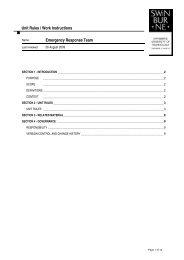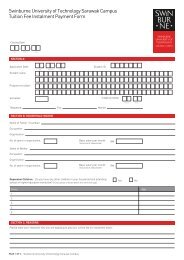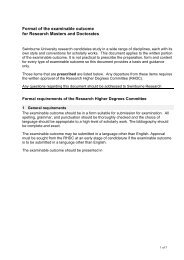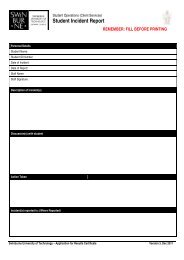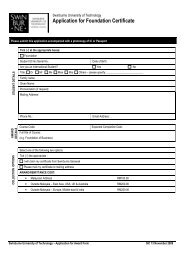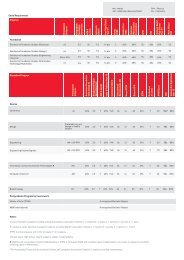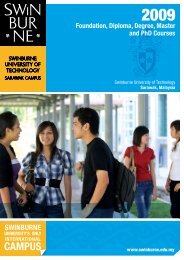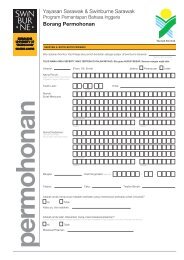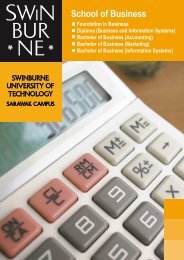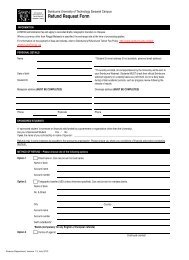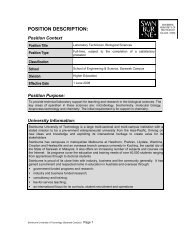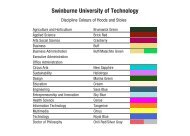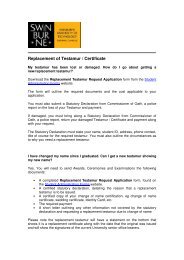SoECS Laboratory Safety Manual - Swinburne University of ...
SoECS Laboratory Safety Manual - Swinburne University of ...
SoECS Laboratory Safety Manual - Swinburne University of ...
Create successful ePaper yourself
Turn your PDF publications into a flip-book with our unique Google optimized e-Paper software.
<strong>SoECS</strong> <strong>Laboratory</strong> <strong>Safety</strong> <strong>Manual</strong><br />
1<br />
<strong>SoECS</strong> <strong>Laboratory</strong> <strong>Safety</strong> <strong>Manual</strong>
Prepared by:<br />
(Health and <strong>Safety</strong><br />
Executive)<br />
Names Signature Date<br />
Nastassia Denis<br />
Reviewed by:<br />
(Senior Lecturer –<br />
Engineering / <strong>Laboratory</strong><br />
Coordinator - <strong>SoECS</strong>)<br />
Approved by:<br />
(Head <strong>of</strong> School - <strong>SoECS</strong>)<br />
Wallace Wong<br />
Anatoli Vakhguelt<br />
Associated to Documents<br />
<br />
<br />
<br />
<br />
<br />
Emergency Management Policy and Procedure<br />
Personal Protective Equipment (PPE)<br />
Incident / Hazard reporting and Investigation Procedure<br />
First Aid Procedure<br />
Hazard Identification Risk Assessment & Control Evaluation (HIRACE) Procedure<br />
Adapted from SUT FEIS <strong>Safety</strong> <strong>Manual</strong> prepared by: P. Watson, Faculty Technical Operations Manager<br />
This safety manual should be reviewed and revised when deemed necessary.<br />
2<br />
<strong>SoECS</strong> <strong>Laboratory</strong> <strong>Safety</strong> <strong>Manual</strong>
CONTENTS<br />
1. Responsibilities 5<br />
Pages<br />
2. General <strong>Laboratory</strong> / Workshop Practices 7<br />
3. Waste Handling 13<br />
3.1 Decontamination<br />
3.2 Biohazard Waste Disposal<br />
3.3 Chemicals Waste Disposal<br />
3.4 Sharps<br />
3.5 Contaminated (potentially infectious) materials for autoclaving and reuse<br />
3.6 Contaminated (potentially infectious) materials for disposal<br />
4. Personal Protective Equipment (PPE) 15<br />
4.1 Lab coats, Gowns, Coveralls, Aprons<br />
4.2 Goggles, <strong>Safety</strong> Spectacles, Face Shields<br />
4.3 Respirators<br />
4.4 Gloves<br />
4.5 Foot Protection<br />
4.6 Ear Protection<br />
4.7 Head Protection<br />
5. Hazardous Chemicals 18<br />
5.1 Store <strong>of</strong> Chemicals<br />
5.2 General Rules Regarding Chemical Incompatibilities<br />
5.3 Toxic Effects <strong>of</strong> Chemicals<br />
5.4 Explosive Chemicals<br />
5.5 Chemical Spills<br />
5.6 Compressed and Liquefied Gases<br />
5.7 Handling <strong>of</strong> Cylinders<br />
5.8 Cryogenic Liquids<br />
5.9 Handling Cryogenic Liquids<br />
5.10 Moving Cylinders<br />
5.11 Material <strong>Safety</strong> Data Sheet (MSDS)<br />
5.12 Labelling<br />
6. Fire Hazards 24<br />
6.1 How To Use an Extinguisher<br />
6.2 Sand / Absorbent Material<br />
6.3 Sprinklers<br />
7. Storage Handling 28<br />
7.1 Type <strong>of</strong> Cabinets<br />
7.2 Refrigerators<br />
7.3 Eye Wash Station<br />
7.4 First Aid Kit<br />
7.5 Emergency<br />
7.6 Fire Drill<br />
3<br />
<strong>SoECS</strong> <strong>Laboratory</strong> <strong>Safety</strong> <strong>Manual</strong>
8. Incident, Hazard Reporting and Identification 30<br />
9. Electrical Hazards 30<br />
10. Noise 30<br />
11. Ionising Radiation 30<br />
11.1 Principles <strong>of</strong> Ionizing Radiation Protect<br />
12. Housekeeping 31<br />
13. Worksite Inspection 32<br />
14. Training 32<br />
Appendix 1 33<br />
Appendix 2 34<br />
Appendix 3 35<br />
Appendix 4 36<br />
Appendix 5 37<br />
Appendix 6 38<br />
Appendix 7 40<br />
Appendix 8 41<br />
Appendix 9 42<br />
4<br />
<strong>SoECS</strong> <strong>Laboratory</strong> <strong>Safety</strong> <strong>Manual</strong>
<strong>Swinburne</strong> <strong>University</strong> <strong>of</strong> Technology (Sarawak Campus) strives to ensure safety and health <strong>of</strong><br />
persons at the <strong>University</strong> and protecting others from safety and health risks in connection to<br />
the activities at the <strong>University</strong>.<br />
The School <strong>of</strong> Engineering & Science (SoES) at the <strong>University</strong> fully embraces the<br />
<strong>University</strong>’s commitment to ensure safe and healthy teaching, learning and research<br />
environment at the School.<br />
This document provides the guidelines for good Occupational <strong>Safety</strong> and Health practices to be<br />
followed by staff, student and visitor at the SoES.<br />
REFERENCES<br />
Name<br />
Occupational <strong>Safety</strong><br />
and Health, 1994<br />
Location<br />
http://www.dosh.gov.my/doshV2/index.php?option=com_phocadownload&view=c<br />
ategory&id=6%3Aregulations-under-occupational-safety-and-health-act-1994-act-<br />
514&Itemid=99&lang=en<br />
WHO <strong>Laboratory</strong><br />
Biosafety <strong>Manual</strong> (3 rd<br />
Edition)<br />
Princeton <strong>University</strong><br />
http://www.who.int/csr/resources/publications/biosafety/Biosafety7.pdf<br />
http://web.princeton.edu/sites/ehs/labsafetymanual/sec7f.htm<br />
<strong>University</strong> <strong>of</strong><br />
Wollongong<br />
http://www.uow.edu.au/content/groups/public/@web/@eng/documents/<br />
doc/uow062918.pdf<br />
John Hopkins<br />
<strong>University</strong><br />
1. Responsibilities<br />
Heads <strong>of</strong> Management units shall:<br />
<br />
<br />
<br />
<br />
http://www.civil.jhu.edu/current-undergraduatefacilities/JHU%20CE%20<strong>Laboratory</strong>%20<strong>Manual</strong>.pdf<br />
To ensure suitable OS&H policies and practices for civil, mechanical, electrical and chemical<br />
laboratories are developed, implemented and continuously improved.<br />
Ensure, as far as is reasonably practicable, that adequate financial provision is made available to<br />
implement the policies and practices<br />
Ensure that staff and students receive the appropriate information, instruction and training<br />
necessary for them to perform work safely;<br />
<strong>Laboratory</strong> Coordinator shall:<br />
Ensure that all staff and students receive an induction that includes information pertaining to<br />
emergency response procedures and personnel;<br />
5<br />
<strong>SoECS</strong> <strong>Laboratory</strong> <strong>Safety</strong> <strong>Manual</strong>
Ensure that local occupational health and safety procedures are developed, documented and<br />
issued to staff and students as appropriate;<br />
<br />
Ensure that the facilities and equipment provided for staff and students are safe and suitable<br />
for the types <strong>of</strong> work to be carried out;<br />
<br />
Ensure that adequate financial provisions are made for occupational health and safety<br />
equipment and materials and the maintaining <strong>of</strong> occupational health and safety standards;<br />
<br />
Ensure that hazard identification and risk assessment procedures are developed,<br />
documented and maintained for the use, handling, storage, transport and disposal <strong>of</strong><br />
equipment, materials and substances and that appropriate risk controls are implemented and<br />
maintained<br />
<br />
To work with the different university departments (facilities, ITS, admin) to ensure OS&H quality.<br />
Staff & Students shall:<br />
<br />
<br />
<br />
<br />
Take reasonable care for their own health & safety, and for the health & safety <strong>of</strong> anyone else who<br />
may be affected by their acts or omissions in the work / study environment.<br />
Follow local arrangements / guidelines developed under this manual and any other additional<br />
requirements or procedures set out by the school.<br />
Report any hazards, incidents / near misses or injury / illness to the laboratory support staff<br />
Attend / participate in any safety training provided.<br />
Staff shall :<br />
Be alert to unsafe conditions and actions, and call attention to them so that<br />
corrections can be made as soon as possible.<br />
<br />
<br />
<br />
<br />
<br />
<br />
Label all storage areas, refrigerators, cabinets, etc. appropriately and keep all<br />
chemicals in properly labelled containers.<br />
Develop and implement a specific OS&H strategy within individual laboratories.<br />
Inform all staff & student <strong>of</strong> the specific hazards (chemicals, equipment) present in<br />
the laboratory and carry out the necessary steps to keep these hazards at bay.<br />
Analyse OS&H risk for all processes in the laboratory.<br />
Prepare Material <strong>Safety</strong> Data Sheets for chemicals available in laboratories.<br />
Obtain advice from Health and <strong>Safety</strong> Executive for the use <strong>of</strong> high-risk chemicals<br />
or equipment and the relevant procedures as required.<br />
The Health and <strong>Safety</strong> Executive shall:<br />
<br />
<br />
<br />
6<br />
Assist Head <strong>of</strong> School and <strong>Laboratory</strong> Coordinator to ensure OHS training has been delivered to<br />
the appropriate personnel to enable them to fulfil their obligations under this manual.<br />
Disseminate information arising from lab hazard to staff and students<br />
Provide training and guidance to Heads <strong>of</strong> School, laboratory coordinator, staff and students<br />
pertaining to safety in the laboratory / workshop<br />
<strong>SoECS</strong> <strong>Laboratory</strong> <strong>Safety</strong> <strong>Manual</strong>
2. General <strong>Laboratory</strong> / Workshop Practices<br />
1. No food and drinks are allowed in the laboratory at all time.<br />
2. No smoking in the laboratory.<br />
3. No horseplay in the laboratory.<br />
4. Only covered shoes are to be worn in the laboratory. Open sandals are not permitted.<br />
5. Shirt or blouse must be at least short sleeves and legs must be covered with long pants<br />
when working in laboratory. Students are not allowed to wear jewelry during laboratory classes /<br />
workshop practical.<br />
6. Long hair must be tied back to reduce fire or chemical hazards.<br />
7. Keep hands and other objects away from your face, nose, eyes, ears and especially mouth. Do<br />
not chew pens, etc.<br />
8. Place bags, books and other personal items in specified location. Never put them on the<br />
working area.<br />
9. Wear the appropriate PPE (e.g. safety glass or goggles) during the experiment / practical<br />
workshops. Everyone is responsible on their own PPE. Do not leave the PPE unused on the table<br />
or on the floor. Return the PPE in its designated location.<br />
10. Report all injuries, accidents and broken equipment immediately to your demonstrators.<br />
Never engaged in horseplay, pranks or other act <strong>of</strong> mischief in the laboratory.<br />
11. Students are NOT permitted to work in the laboratory / workshop unless the demonstrator or<br />
laboratory instructor is present.<br />
12. Familiarize yourself with the safety equipment (safety shower, emergency eyewash, fire<br />
blanket, and fire extinguisher) in the laboratory and emergency escape routes.<br />
13. The use <strong>of</strong> contact lenses is not advisable. Even when worn under safety goggles, various fumes<br />
may accumulate under the lens and cause serious injuries or blindness.<br />
Microbiology / Biology / Biochemistry <strong>Laboratory</strong> Practices and <strong>Safety</strong> Rules<br />
14. Wash your hands with disinfectants soap when you enter the laboratory and again before you<br />
leave the laboratory.<br />
15. <strong>Laboratory</strong> coats must be worn and buttoned in the laboratory.<br />
16. Disposable gloves and other protective equipment (safety glass or goggles) have to be worn<br />
during the experiment.<br />
17. Thick insulated gloves must be worn to remove items from hot water baths. The lids <strong>of</strong> water<br />
baths must be opened such that the opening is away from the user. Never put a hand into the<br />
water baths to check for temperature. Use a thermometer.<br />
18. Working area must be disinfected with 70% ethanol at the beginning <strong>of</strong> the practical session<br />
and again when you have finished the exercises.<br />
19. Do not work with an uncovered cut. Bandages and gloves are available if needed.<br />
7<br />
<strong>SoECS</strong> <strong>Laboratory</strong> <strong>Safety</strong> <strong>Manual</strong>
20. Be careful around Bunsen burner. Turn the burner on only when you are ready to use it and turn<br />
it <strong>of</strong>f immediately after use even if you have to use it for several short intervals. Blue flame <strong>of</strong><br />
Bunsen burner is <strong>of</strong>ten difficult to see.<br />
21. All cultures should be handled as being potentially pathogenic and the following precautions<br />
should be observed at all times:<br />
a) Label all materials and cultures with your name, date and any other applicable<br />
information (e.g., media, organism and etc)<br />
b) Cultures must always be carried in a test tube rack when moving around the<br />
laboratory.<br />
c) Cultures must be kept in a test tube rack on the bench tops when not in use.<br />
d) Inoculating loops and needles should be flame sterilized in a Bunsen burner before<br />
you lay them on the bench top.<br />
e) Do not walk around the laboratory with loops or pipettes containing infectious<br />
materials.<br />
f) Never pipette anything by mouth including broth cultures and water. Always use the<br />
pipetting devices.<br />
g) Report any chemical or biological fluid spillages to your demonstrators. Do not attempt<br />
to clean the spillages yourself.<br />
h) Never take cultures out <strong>of</strong> the laboratory unless absolute necessary.<br />
22. Note the hazard code on the bottle when handling chemicals and take the appropriate precautions<br />
indicated. Read all labels on chemicals twice before using them in the laboratory.<br />
23. Never leave sharp items (knives, forceps, surgical blades and needles) on the workbench<br />
which can hurt yourself or someone. All sharp instruments must remain in their wrappings until you<br />
are ready to use it.<br />
24. Removal <strong>of</strong> equipment and media from laboratory is prohibited without written permission <strong>of</strong><br />
the demonstrators or laboratory instructors.<br />
25. Dispose waste into their proper containers. (see Biohazard Waste Disposal below).<br />
26. Do not pour anything down the sink. Autoclave liquids and broth cultures to sterilize them<br />
before discarding them.<br />
27. Dispose all solid waste materials in a biohazard bag and autoclave them before discarding in<br />
the regular trash.<br />
28. Glassware should be washed with soap and water, and then rinsed with distilled water.<br />
29. Return all chemicals, reagents, culture and glassware to their appropriate places.<br />
Handling Life Culture<br />
30. Treat all microorganisms as if they were harmful. Use antiseptic procedures, as directed by your<br />
lecturer when working with microbes. Dispose <strong>of</strong> microbes as your lecturer directs.<br />
31. Treat living organisms carefully. Do not cause pain, discomfort, or injury to an organism. Follow<br />
your lecturer's directions when handling animals. Wash your hands thoroughly after handling<br />
animals or their cages.<br />
8<br />
<strong>SoECS</strong> <strong>Laboratory</strong> <strong>Safety</strong> <strong>Manual</strong>
Preparation for Lab Work<br />
32. Prepare for the experiment by reading all <strong>of</strong> the directions before you start the lab. Be sure you<br />
understand all directions. Discuss the procedures with your lab partner or team. Assign specific<br />
tasks to individuals, especially if time is a factor in the procedure.<br />
33. Before you begin work, make sure that you know how to operate the equipment that will be used in<br />
the experiment.<br />
34. After you have completed your work, turn <strong>of</strong>f all equipment and clean your work area. Return all<br />
equipment and materials to the place that you got them. Report any broken or missing equipment.<br />
35. Keep hands away from your face, eyes, mouth and body while using chemicals or preserved<br />
specimens. Wash your hands before and after each experiment.<br />
36. Perform only those experiments authorized by your teacher. Never do an experiment that is not<br />
called for in the laboratory procedures or your instructor.<br />
37. Do not work alone in the lab. When entering the room, do not touch any equipment, chemicals or<br />
other materials in the laboratory area until you are instructed to do so.<br />
38. Experiments must be personally monitored at all times. You will be assigned a laboratory station<br />
at which to work. Do not wander around the room, distract other students, or interfere with the<br />
laboratory experiments <strong>of</strong> others.<br />
Handling Chemicals, Equipment & Glassware<br />
39. Read the labels on chemical containers twice. Label all containers into which you put materials.<br />
40. Do not touch, taste, or smell chemicals unless directed to by your lecturer. Waft fumes toward<br />
your nose by waving your hand over the mouth <strong>of</strong> the container if directed to smell a chemical.<br />
41. Take only what you need to avoid the contamination <strong>of</strong> chemicals. Do not return unused chemicals<br />
to the bottle. Dispose <strong>of</strong> chemicals only as directed by your lecturer.<br />
42. Always pour acid into water; never pour water into acid.<br />
43. Do not use your mouth to draw liquids into a pipette; use a pipette bulb.<br />
44. Never point the open end <strong>of</strong> a heated test tube toward yourself or anyone else.<br />
45. Do not use cracked, chipped, scored, or badly scratched glassware.<br />
46. Never handle broken glass with your bare hands.<br />
47. Allow plenty <strong>of</strong> time for hot glass to cool before touching it. It shows no visible signs <strong>of</strong> its<br />
temperature, and can cause painful burns.<br />
48. Learn the names <strong>of</strong> the equipment and glassware you use so there is no misunderstanding.<br />
49. Handle all equipment as directed. Note safety precautions in the instructions for your experiments.<br />
50. Handle all sharp instruments with extreme care. Never try to catch falling sharp instruments<br />
51. Do not stir solutions with a thermometer; use a glass stirring rod. If a thermometer breaks, inform<br />
your teacher at once. Do not touch the mercury from broken mercury thermometers.<br />
52. Take extreme care not to spill materials in the lab. Report all spills immediately, and follow your<br />
9<br />
<strong>SoECS</strong> <strong>Laboratory</strong> <strong>Safety</strong> <strong>Manual</strong>
lecturer’s directions for cleaning them up. Keep your lab area neat and clean.<br />
53. Never use an open flame in Biology lab. Use tongs or a clamp to pick up hot containers. Test the<br />
temperatures <strong>of</strong> equipment and containers that have been heated by placing the back <strong>of</strong> your hand<br />
near any object before picking it up. If you can feel heat, the object might be too hot to handle.<br />
54. Dispose <strong>of</strong> materials only as directed. Do not pour chemicals or other solids into a sink or put<br />
specimens or their parts into the trash or sink.<br />
Access to <strong>Laboratory</strong> / Workshop<br />
55. Permitted lab users got no authorisation to allow other people (i.e. friends, family, group members)<br />
to enter the laboratory to joint in/help out the experiment, or for leisure purposes. Official written<br />
permission is required if more members are needed to conduct the experiment. Existing user may<br />
only grant enter permission to others for purpose <strong>of</strong> collecting and sending in samples to the<br />
laboratory, but general safety codes must be strictly followed.<br />
Working Alone<br />
56. Working alone refers to situations where people may be exposed to risks because:<br />
• the area they are working in is remote from others or isolated from the assistance <strong>of</strong> others<br />
because the nature, time or location <strong>of</strong> their work; or<br />
• it involves the operation or maintenance <strong>of</strong> equipment, or the handling <strong>of</strong> a hazardous<br />
substance; or<br />
• the work is dangerous for a person to perform alone<br />
Where any <strong>of</strong> the above is applicable, working alone must be avoided.<br />
For working alone, the following apply:<br />
• Staff and students may work alone in <strong>of</strong>fice environments, however, they must have<br />
completed the after hours access permission from laboratory support staff.<br />
• Staff and students must not work alone in workshops/laboratories where medium to high<br />
risk equipment is to be used.<br />
• Emergency assistance – refer to the Emergency poster for important contacts.<br />
Chemistry / Biochemistry <strong>Laboratory</strong> Practices and <strong>Safety</strong> Rules<br />
57. Wear disposable gloves or safety glasses when appropriate.<br />
58. Use UV goggles and protective clothing when work with UV light box. This is to minimize the<br />
risk or exposure to the UV light.<br />
59. Thick insulated gloves must be worn to remove items from hot water baths. The lids <strong>of</strong> water<br />
baths must be opened such that the opening is away from the user. Never put a hand into the<br />
water baths to check for temperature. Use a thermometer.<br />
60. Appropriate protective gloves must be worn for removing or placing items into freezers and<br />
while using liquid nitrogen.<br />
10<br />
<strong>SoECS</strong> <strong>Laboratory</strong> <strong>Safety</strong> <strong>Manual</strong>
61. Do not touch the hot plate directly to find out whether it is hot.<br />
62. Do not work with an uncovered cut. Bandages and gloves are available if needed.<br />
63. Be careful around Bunsen burner. Turn the burner on only when you are ready to use it and turn<br />
it <strong>of</strong>f immediately after use even if you have to use it for several short intervals. Blue flame <strong>of</strong><br />
Bunsen burner is <strong>of</strong>ten difficult to see.<br />
64. Mouth pipetting is prohibited under all circumstances.<br />
65. Note the hazard code on the bottle when handling chemicals and take the appropriate<br />
precautions indicated. Read all labels on chemicals twice before using them in the laboratory.<br />
66. Keep all noxious and volatile chemicals in the fume hood.<br />
67. Do not dispose hazardous or noxious chemicals into the sink. All chemicals are to be<br />
disposed in waste containers. Pay attention to the waste container labels before adding the<br />
chemical to be discarded<br />
68. Always add acids to water and never water to acids.<br />
69. When using reagent, replace the lid immediately after used. Never return unused reagents to<br />
the stock bottles. Take only the amount needed for the experiment.<br />
70. Use caution when testing for odors. Never inhale the fumes directly. Waft them towards your<br />
nose carefully.<br />
71. Never leave sharp items (knives, forceps, surgical blades and needles) on the workbench<br />
which can hurt yourself or someone. All sharp instruments must remain in their wrappings until you<br />
are ready to use it.<br />
72. Do not use force for inserting glass pipettes or Pasteur pipettes into the rubber bulbs or<br />
dispensers. These can break and cause severe cuts. Use the bulbs or dispensers <strong>of</strong> a size which<br />
is appropriate for the size <strong>of</strong> the pipettes.<br />
73. Do not use any electrical equipment with frayed wirer or connections. This is most dangerous<br />
and will cause electrical shocks.<br />
74. Dispose <strong>of</strong> all biological waste in appropriate receptacles. Living cultures have to be treated<br />
with Clorox bleach or autoclaved. Never toss them into regular trash or down the drains without<br />
autoclaving.<br />
75. Dispose waste into their proper containers. (see Biohazard Waste Disposal below)<br />
76. Removal <strong>of</strong> equipment and media from laboratory is prohibited without proper authorization.<br />
77. Glassware should be washed with soap and water, and then rinsed with distilled water.<br />
78. Return all chemicals, reagents, and glassware to their appropriate place.<br />
11<br />
<strong>SoECS</strong> <strong>Laboratory</strong> <strong>Safety</strong> <strong>Manual</strong>
Engineering Workshop Practices and <strong>Safety</strong> Rules<br />
79. Attire: In the labs, students must wear appropriate cloths for the work being performed. Loose<br />
cloths and shorts are not allowed. Jewelry is prohibited during workshops.<br />
80. Toe Protection: Students must always wear closed-toe shoes in the labs. Sandals and heels are<br />
not allowed.<br />
81. Eye Protection: Flying objects, tools, and particles cause eye injuries. In addition to the proper use<br />
<strong>of</strong> machine guards and screens, eye protection such as safety glasses and goggles must be used<br />
during the work that may have potential hazard to eyes including sawing, cutting, drilling, grinding,<br />
etc. Pairs <strong>of</strong> safety glasses can be found with the laboratory support staff.<br />
82. Hand Protection: Students must wear safety gloves during the work that may have any hazard to<br />
hands (e.g., lifting heavy metal pieces). Pairs <strong>of</strong> gloves can be found with the laboratory support<br />
staff.<br />
83. Head Protection: While working on assembly <strong>of</strong> test setups and perform dynamic or destructive<br />
tests, students have to wear hard hat to protect their head. Hard hats can be found with the<br />
laboratory support staff.<br />
84. Mouth Protection: During the work that have potential risks for air quality such as soldering and<br />
painting, wear protection masks. Masks can be found with the laboratory support staff.<br />
85. Ear Protection: While using noisy power tools such as band saws, use ear plugs or protection to<br />
prevent ear injuries. Ear plugs can be found with the laboratory support staff.<br />
86. Common Sense: Use common sense to ensure safety <strong>of</strong> the work in the labs. If you are not sure<br />
about the safety <strong>of</strong> your work, never attempt. Ask the laboratory support staff.<br />
87. Awareness: If you observe a potentially dangerous act in the labs, report it to the laboratory<br />
coordinator or the laboratory support staff. It is your responsibility to reduce risks <strong>of</strong> injuries and<br />
accidents in the workshop.<br />
88. Electric Power: Read specifications <strong>of</strong> the devices prior to connecting power supplies. Use only the<br />
specified power supply. Securely cover extension cords to prevent accidental power loss.<br />
89. Hydraulic Power: Hydraulic systems used for actuators and loading frames are under high<br />
pressure. Before starting hydraulic pumps, always check that valves are closed and connections<br />
are clean. If leakage is found, stop the pump immediately and notify the laboratory support staff.<br />
90. Ventilation: Do not turn <strong>of</strong>f ventilation fans to keep the air in the labs clean. If extra ventilation is<br />
needed (e.g., in case <strong>of</strong> indoor painting), consult the laboratory support staff and arrange the<br />
schedule to perform the required work.<br />
91. Lifting and Moving Heavy Items: When lifting and moving <strong>of</strong> heavy items are required, students<br />
must consult the laboratory support staff. Do not attempt without presence <strong>of</strong> at least one <strong>of</strong> them.<br />
Use protection items and appropriate items such as overhead crane with an assistance <strong>of</strong><br />
laboratory support staff.<br />
12<br />
<strong>SoECS</strong> <strong>Laboratory</strong> <strong>Safety</strong> <strong>Manual</strong>
3. Waste Handling<br />
3.1 Decontamination<br />
Steam autoclaving is the preferred method for all decontamination processes. Materials for<br />
decontamination and disposal should be placed in containers, e.g. autoclavable plastic bags, that are<br />
colour-coded to whether the contents are to be autoclaved and/or incinerated. Alternative methods<br />
may be envisaged only if they remove and/or kill microorganisms.<br />
Handling and disposal procedures for contaminated materials and wastes<br />
1. Non-contaminated (non-infectious) waste that can be used or recycled or disposed <strong>of</strong> a<br />
general “household waste”<br />
2. Contaminated (infectious) “sharps” – hypodermic needles, scalpels, knives and broken glass;<br />
these should always be collected in puncture-pro<strong>of</strong> containers fitted with covers and treated as<br />
infectious<br />
3. Contaminated material for decontamination by autoclaving and thereafter washing and reuse<br />
or recycling<br />
4. Contaminated material for autoclaving and disposal<br />
5. Contaminated material for direct incineration<br />
3.2 Biohazard Waste Disposal<br />
Dispose <strong>of</strong> items are indicated as below. Any question regarding the proper disposal, please ask your<br />
demonstrators or laboratory instructors.<br />
Table 1 : Biohazard Waste Disposal<br />
Material<br />
Agar slants with biological material<br />
Biological liquids<br />
Petri dishes and contaminated solids<br />
Broken glass (contaminated)<br />
Broken glass (not contaminated)<br />
Cotton swabs, Pasteur pipette, disposable<br />
tips, glass slides (contaminated)<br />
Method <strong>of</strong> disposal<br />
Place in autoclave bag and autoclave them<br />
before discard in trash can.<br />
Place in autoclave bag and autoclave them<br />
before discard in trash can.<br />
Place in autoclave bag and autoclave them<br />
before discard in trash can.<br />
Disinfected with disinfectant and then place<br />
in sharps container<br />
Sharps container<br />
Disinfectant container (beakers or cylinder)<br />
13<br />
<strong>SoECS</strong> <strong>Laboratory</strong> <strong>Safety</strong> <strong>Manual</strong>
Needles, syringes, pipette, other types <strong>of</strong><br />
sharps<br />
Non-contaminated paper<br />
Sharps container<br />
Regular trash<br />
3.3 Chemicals Waste Disposal<br />
Dispose <strong>of</strong> items are indicated as below. Any question regarding the proper disposal, please consult<br />
the laboratory support staff for advice. In general, waste products may be disposed <strong>of</strong> in three ways:<br />
1. Chemicals that are toxic, or harmful to the environment, should be placed in the bins provided<br />
for their waste.<br />
2. Chemicals, which are mildly toxic, but not harmful to the environment, may be washed down<br />
the sinks located in the fume cupboards.<br />
3. Chemicals that are neither toxic nor harmful to the environment may be flushed down the<br />
sinks. In general you will be informed when this is safe to do so.<br />
4. Do not put acidic or basic waste (pH 9) in metal cans. Metal cans corrode in a very<br />
short time. Keep acids and bases separate from hydrocarbons and ethers.<br />
5. When possible, keep all carcinogens/mutagens/teratogens separate from other waste. Keep<br />
aqueous wastes separate from organic solvents. Keep halogenated solvents and wastes<br />
separate from non-halogenated solvents. DO NOT FILL CONTAINERS TO THE TOP. Fill<br />
plastic carboys ONLY to the fill line. Leave about 50 mm at the top <strong>of</strong> all other containers. All<br />
waste must reside in closed, non-leaking containers. Do not use flasks or test tubes with<br />
stoppers, beakers with parafilm, or bottles with ground glass stoppers. The outside <strong>of</strong> the<br />
waste container must be reasonably clean.<br />
6. Do not put liquids (especially phenol) in bottles designed for solids. They leak!<br />
7. All chemical waste containers must remain CLOSED (capped).<br />
For proper chemical disposal, please refer to Material <strong>Safety</strong> Data Sheet (MSDS) prepared in the lab.<br />
3.4 Sharps<br />
After use, hypodermic needles should not be recapped, clipped or removed from disposable syringes.<br />
The complete assembly should be placed in a sharps disposal container. Disposable syringes, used<br />
alone or with needles, should be placed in sharps disposal containers and incinerated, with prior<br />
autoclaving if required.<br />
Sharps disposal containers must be puncture-pro<strong>of</strong>/-resistant and must not be filled to capacity. When<br />
they are three quarters full they should be placed in “infectious waste” containers and incinerated, with<br />
prior autoclaving if laboratory practice requires it. Sharps disposal containers must not be discarded in<br />
landfills.<br />
3.5 Contaminated (Potentially Infectious) Materials for Autoclaving and Reuse<br />
No pre-cleaning should be attempted <strong>of</strong> any contaminated (potentially infectious) materials to be<br />
autoclaved and reused. Any necessary cleaning or repair must be done only after autoclaving or<br />
disinfection.<br />
3.6 Contaminated (Potentially Infectious) Materials for Disposal<br />
Apart from sharps, which are dealt with above, all contaminated (potentially infectious) materials<br />
14<br />
<strong>SoECS</strong> <strong>Laboratory</strong> <strong>Safety</strong> <strong>Manual</strong>
should be autoclave in leakpro<strong>of</strong> containers, e.g. autoclavable, colour-coded plastic bags, before<br />
disposal.<br />
4. Personal Protective Equipment (PPE)<br />
4.1 <strong>Laboratory</strong> Coats, Gowns, Coveralls, Aprons<br />
<strong>Laboratory</strong> coats should preferably be fully buttoned. Aprons may be worn over laboratory coats<br />
or gowns where necessary to give further protection against spillage <strong>of</strong> chemicals or biological<br />
materials such as blood or culture fluids.<br />
Different clothing materials protect against different elements:<br />
Type <strong>of</strong> Material<br />
Function<br />
Cotton - protects against flying objects, sharp or rough edges,<br />
and is a good fire retardant.<br />
Synthetic Fibres - protect against sparks, infrared and ultraviolet radiation.<br />
However, synthetic fibre lab coats can adversely magnify<br />
the effects <strong>of</strong> some laboratory hazards. For instance, some<br />
solvents may dissolve particular classes <strong>of</strong> synthetic fibres,<br />
thereby diminishing the protective ability <strong>of</strong> the coat.<br />
In addition, on contact with flames, some synthetic fibres<br />
will melt. This molten material can cause painful skin burns<br />
and release irritating fumes.<br />
Wool - protects against splashes <strong>of</strong> molten materials,<br />
small quantities <strong>of</strong> acid, and small flames.<br />
Aluminised and<br />
Reflective Clothing<br />
- protect against radiant heat<br />
Table 2 : Clothing Materials<br />
4.2 Goggles, <strong>Safety</strong> Spectacles, Face Shields<br />
The choice <strong>of</strong> equipment to protect eyes and face from splashes and impacting objects will<br />
depend on the activity performed. Prescription or plain eye glasses can be manufactured with<br />
special frames that allow lenses to be placed in frame from the front, using shatterpro<strong>of</strong> material<br />
either curved or fitted with side shields (safety glasses).<br />
<strong>Safety</strong> spectacles do not provide for adequate splash protection even when side shields are<br />
worn with them. Goggles for splash and impact protection should be worn over normal<br />
prescription against biological or chemical hazards). Face shields (visors) are made <strong>of</strong><br />
shatterpro<strong>of</strong> plastic, fit over the face and are held in place by head straps or caps.<br />
Goggles, safety spectacles, or face shields should not be worn outside the laboratory areas.<br />
4.3 Respirators<br />
Respiratory protection may be used when carrying out high-hazard procedures (e.g. cleaning up<br />
a spill <strong>of</strong> infectious material). The choice <strong>of</strong> respirator will depend on the type <strong>of</strong> hazard (s).<br />
Respirators are available with interchangeable filters for protection against gases, vapours,<br />
particulates and microorganisms. It is imperative that the filter is fitted in the correct type <strong>of</strong><br />
respirator. To achieve optimal protection, respirators should be individually fitted to the<br />
operator’s face and tested. Fully self-contained respirators with an integral air supply provide full<br />
protection. Advice should be sought from a suitably qualified person e.g. an occupational<br />
hygienist, for selection <strong>of</strong> the correct respirator. Surgical type masks are designed solely for<br />
patient protection and do not provide respiratory protection to workers.<br />
15<br />
<strong>SoECS</strong> <strong>Laboratory</strong> <strong>Safety</strong> <strong>Manual</strong>
Respirators should not be worn outside the laboratory areas.<br />
4.4 Gloves<br />
Aside from acting as a shield between hands and hazardous materials, some<br />
gloves can also absorb perspiration and protect the hands from heat. Certain<br />
glove types can dissolve when in contact with solvents, it is important to take<br />
extra care in matching the protective glove with the nature <strong>of</strong> the job. Before<br />
use, check to make sure the gloves (especially latex gloves) are in good<br />
condition and free from holes, punctures and tears.<br />
Aside from acting as a shield between hands and hazardous materials, some<br />
gloves can also absorb perspiration and protect the hands from heat. Certain<br />
glove types can dissolve when in contact with solvents, it is important to take<br />
extra care in matching the protective glove with the nature <strong>of</strong> the job. Before<br />
use, check to make sure the gloves (especially latex gloves) are in good<br />
condition and free from holes, punctures and tears.<br />
When working with extremely corrosive material, wear thick gloves. Take extra<br />
precaution in checking for holes, punctures, and tears.<br />
Care should be taken when removing gloves. Peel the glove <strong>of</strong>f the hand,<br />
starting at the wrist and working toward the fingers. Keep the working surface<br />
<strong>of</strong> the glove from contacting skin during removal. Disposable gloves should be<br />
discarded in designated containers (e.g. regulated medical waste containers).<br />
Type <strong>of</strong> Gloves<br />
Function<br />
Plastic - protects against light corrosives and irritants<br />
Latex - provides light protection against irritants<br />
(some people can<br />
have an allergic reaction to latex which can lead to a<br />
serious medical<br />
condition).<br />
Natural Rubber - protects against light corrosive material and electric<br />
shock.<br />
Neoprene - for working with solvents, oils, or light corrosive<br />
material.<br />
Cotton - absorbs perspiration, keeps objects clean,<br />
provides some fire<br />
retarding properties.<br />
Zetex - when handling small burning objects. These<br />
are a good<br />
replacement for asbestos gloves.<br />
Asbestos - BANNED<br />
Table 3 : Type <strong>of</strong> Gloves<br />
16<br />
Disposable microbiologically approved latex, vinyl or nitrile surgical-type gloves are used widely<br />
for general laboratory work, and for handling infectious agents and blood and body fluids.<br />
Reusable gloves may also be used but attention be given to their correct washing, removal,<br />
cleaning and disinfection.<br />
Gloves should be removed and hands thoroughly washed after handling infectious materials,<br />
working in a biological safety cabinet and before leaving the laboratory. Used disposable gloves<br />
<strong>SoECS</strong> <strong>Laboratory</strong> <strong>Safety</strong> <strong>Manual</strong>
should be discarded with infected laboratory wastes.<br />
4.5 Foot Protection<br />
a. Foot protection is designed to prevent injury from corrosive chemicals, heavy objects,<br />
electrical shock, as well as giving traction on wet floors. If a corrosive chemical or heavy<br />
object were to fall on the floor the most vulnerable portion <strong>of</strong> the body would be the feet. For<br />
this reason shoes that COMPLETELY COVER AND PROTECT the foot are recommended.<br />
b. Fabric shoes, such as tennis shoes absorb liquids readily. If chemicals happen to spill onto<br />
fabric shoes, remove the footwear immediately.<br />
c. When selecting footwear for the laboratory or workshop, choose sturdy leather shoes that<br />
cover the foot, these will provide the best protection.<br />
d. The following shoe types should not be worn in the laboratory/workshop:<br />
i. Sandals<br />
ii. Thongs<br />
iii. Clogs<br />
High heels shoes that expose the foot IN ANY WAY<br />
e. The following are recommended types <strong>of</strong> footwear:<br />
i. <strong>Safety</strong> Toe Shoes (steel-toed) --protect against crushing injuries caused by impact from<br />
any object during work activities (e.g., lifting heavy objects, using power tools, etc.).<br />
ii.<br />
Treated shoes, Rubber Boots or Plastic Shoe Covers --protect against corrosive<br />
chemicals.<br />
iii.<br />
Insulated Shoes – when welding they will protect against electric shock.<br />
4.6 Ear Protection<br />
Ear protection should be worn where the noise level is above 85 decibels<br />
(dB). Areas where excessive noise is present should be posted with signs<br />
indicating ear protection is required.<br />
Ear protectors should be readily available and composed <strong>of</strong> rubber or plastic.<br />
Types <strong>of</strong> ear protection include:<br />
i. Earplugs --provide basic protection to seal the ear against noise and<br />
are to be disposed <strong>of</strong> after use.<br />
ii. Ear muffs --provide extra protection against noise and are more<br />
comfortable than earplugs and are recommended for prolong use.<br />
iii. Cotton inserts --are poor suppressers <strong>of</strong> noise and should be avoided.<br />
17<br />
<strong>SoECS</strong> <strong>Laboratory</strong> <strong>Safety</strong> <strong>Manual</strong>
4.7 Head Protection<br />
a. Some environments within the <strong>University</strong> and <strong>of</strong>f site have the potential for falling or flying<br />
objects. In these situations, appropriate head protection will protect workers from impacts,<br />
penetration by falling and flying objects, electric shock and burns.<br />
b. Unrestrained long hair can be hazardous the use <strong>of</strong> caps, elastic bands or hair nets will<br />
prevent the hair from coming into contact with instruments/machinery parts or flame-producing<br />
sources.<br />
5. Hazardous Chemicals<br />
Routes <strong>of</strong> exposure<br />
Exposure to hazardous chemicals may occur by:<br />
1. Inhalation<br />
2. Contact<br />
3. Ingestion<br />
4. Needle-sticks<br />
5. Through broken skin<br />
5.1 Store <strong>of</strong> Chemicals<br />
Only amounts <strong>of</strong> chemicals necessary for daily use should be stored in the laboratory.<br />
Bulk stocks should be kept in specially designated rooms or buildings.<br />
Chemicals should not be stored in alphabetical order.<br />
5.2 General rules regarding chemical incompatibilities<br />
To avoid fire and/or explosions, substances below should be stored and handled so that<br />
they cannot come into contact with the corresponding substances in the right-hand<br />
column <strong>of</strong> the table.<br />
Substance Category<br />
Alkali metals, e.g.<br />
sodium, potassium,<br />
caesium and lithium<br />
Incompatible Substances<br />
Carbon dioxide, chlorinated<br />
hydrocarbons, water<br />
Halogens<br />
Acetic acid, hydrogen<br />
sulphide, aniline,<br />
hydrocarbons,<br />
sulphuric acid<br />
Ammonia, acetylene, hydrocarbons<br />
Oxidizing agents, e.g. chromic acid,<br />
nitric acid, peroxides,<br />
permanganates<br />
Table 4 : Chemical Incompatibilities<br />
18<br />
<strong>SoECS</strong> <strong>Laboratory</strong> <strong>Safety</strong> <strong>Manual</strong>
5.3 Toxic effects <strong>of</strong> Chemicals<br />
Some chemicals adversely affect the health <strong>of</strong> those who handle them or inhale their<br />
vapours. Apart from overt poisons, a number <strong>of</strong> chemicals are known to have various<br />
toxic effects. The respiratory system, blood, lungs, liver, kidneys and the gastrointestinal<br />
system, as well as other organs and tissues may be adversely affected or seriously<br />
damaged. Some chemicals are known to be carcinogenic or teratogenic.<br />
Some solvent vapours are toxic when inhaled. Apart from the more serious effects noted<br />
above, exposure may result in impairments that show no immediate discernible effects<br />
on health, but can include lack <strong>of</strong> coordination, drowsiness and similar symptoms,<br />
leading to an increased proneness to accident.<br />
Prolonged or repeated exposure to the liquid phase <strong>of</strong> many organic solvents can result<br />
in skin damage. This may be due to a defatting effect, but allergic and corrosive<br />
symptoms may also arise.<br />
5.4 Explosive Chemicals<br />
Azides, <strong>of</strong>ten used in antibacterial solutions, should not be allowed to come into contact<br />
with copper or lead (e.g. in waste pipes and plumbing), as they may explode violently<br />
when subjected even to a mild impact.<br />
Ethers that have aged and dried to crystals are extremely unstable, and potentially<br />
explosive.<br />
Perchloric acid, if allowed to dry on woodwork, brickwork or fabric, will explode and<br />
cause a fire on impact.<br />
Picric acid and picrates are denoted by heat and impact.<br />
5.5 Chemical Spills<br />
Most manufacturers <strong>of</strong> laboratory chemicals issue charts describing methods for dealing<br />
with spills. Spillage charts and spillage kits are also available commercially. Appropriate<br />
charts should be displayed in a prominent position in the laboratory. The following<br />
equipment should also be provided:<br />
1. Chemical spill kits<br />
2. Protective clothing<br />
3. Scoops and dustpans<br />
4. Forceps for picking up broken glass<br />
5. Mops, clothes and paper towels<br />
6. Buckets<br />
7. Soda ash (sodium carbonat) or sodium bicarbonate for neutralizing acids and<br />
corrosive chemcials<br />
8. Sand<br />
9. Non-flammable detergent<br />
19<br />
<strong>SoECS</strong> <strong>Laboratory</strong> <strong>Safety</strong> <strong>Manual</strong>
The following actions should be taken in the event <strong>of</strong> a significant chemical spill.<br />
1. Notify the appropriate safety <strong>of</strong>ficer<br />
2. Evacuate non-essential personnel from the area<br />
3. Attend to persons who may have been contaminated<br />
4. If the spilled material is flammable, extinguish all open flames, turn <strong>of</strong>f gas in the<br />
room and adjacent areas, open windows (if possible) and switch <strong>of</strong>f electrical<br />
equipment that may spark<br />
5. Avoid breathing vapour from spilled material<br />
6. Establish exhaust ventilation if it is safe to do so<br />
7. Secure necessary items to clean up the spill<br />
5.6 Compressed and Liquefied Gases<br />
Container<br />
Compressed<br />
gas cylinders<br />
and liquefied<br />
gas containers<br />
Small, singleuse<br />
gas<br />
cylinders<br />
Storage Information<br />
Should be securely fixed (e.g.<br />
chained) to the wall or a solid bench<br />
so that they are not inadvertently<br />
dislodged<br />
Must be transported with their caps in<br />
place and supported on trolleys<br />
Should be stored in bulk in an<br />
appropriate facility at some distance<br />
from the laboratory. This area should<br />
be locked and appropriately<br />
identified.<br />
Should not be placed near radiators,<br />
open flames other heat sources,<br />
sparking electrical equipment, or in<br />
direct sunlight.<br />
Must not be incinerated<br />
The main high-pressure valve should be turned <strong>of</strong>f when the equipment is not in use and<br />
when the room is unoccupied.<br />
Rooms where flammables gas cylinders are used and/or stored should be identified by<br />
warning notices on the doors.<br />
20<br />
<strong>SoECS</strong> <strong>Laboratory</strong> <strong>Safety</strong> <strong>Manual</strong>
Compressed gas containers may be labelled in five ways:<br />
Type <strong>of</strong> Gas<br />
Type <strong>of</strong> Label<br />
Flammable Gas labels show a flame on red label.<br />
Non-flammable<br />
Gas<br />
labels depict a gas canister on a<br />
green<br />
background.<br />
Poisonous Gas labels show skull and crossbones.<br />
Oxygencontaining<br />
Gas<br />
labels are designated by a flaming<br />
letter "O".<br />
Chlorine Gas labels are distinctly marked.<br />
Table 6 : Labelling <strong>of</strong> gas containers<br />
5.7 Handling <strong>of</strong> Cylinders<br />
1. The contents <strong>of</strong> the cylinder or compressed gas should be clearly marked and<br />
identified with proper labels or tags on the shoulder <strong>of</strong> the cylinder. Those<br />
cylinders or compressed gases that do not comply with identification<br />
requirements should be returned.<br />
2. If two labels are associated with one cylinder, affix the labels 180°apart on<br />
the shoulder <strong>of</strong> each cylinder. Label all empty cylinders EMPTY or MT and<br />
date the tag.<br />
3. All regulators, gauges, valves, manifolds, must be designed for the particular<br />
pressures and gases involved and should be checked regularly.<br />
4. All cylinders should be stored in cool, dry, well-ventilated surroundings and<br />
away from all flammable substances including oil, greases, and gasoline.<br />
5. Cylinders should not be located where objects may strike or fall on them.<br />
6. DO NOT use cylinders for rolling, supports, or any purpose other than the<br />
transportation and supply <strong>of</strong> gas.<br />
7. Cylinders should not be stored in damp areas, or near salt, corrosive<br />
chemicals, fumes, heat, or direct sunlight. Store cylinders by gas type,<br />
separating oxidizing gases from flammable gases.<br />
8. All cylinders and compressed gases (full or empty) should be properly<br />
fastened and supported by straps, belts, buckles, or chains to prevent them<br />
from falling and causing bodily harm.<br />
9. A cylinder should only be moved while strapped to a wheel cart to ensure<br />
stability. When storing or moving cylinders, always attach safety caps.<br />
10. All cylinders should be checked for damage prior to use. DO NOT attempt to<br />
repair damaged cylinders. Damaged or defective cylinders, valves, etc., must<br />
be taken out <strong>of</strong> use immediately and returned to the manufacturer for repair.<br />
21<br />
11. Each regulator valve should be inspected annually. Never force valve or<br />
<strong>SoECS</strong> <strong>Laboratory</strong> <strong>Safety</strong> <strong>Manual</strong>
egulator connections. Threads and the configuration <strong>of</strong> valve outlets are<br />
different for each family <strong>of</strong> gases to prevent mixing <strong>of</strong> incompatible gases.<br />
12. Open cylinder valves SLOWLY. Do not use a wrench to open or close a hand<br />
wheel type cylinder valve. If it cannot be operated by hand, the valve should<br />
be repaired.<br />
13. DO NOT subject any part <strong>of</strong> a cylinder to a temperature higher than 50 °C. DO<br />
NOT drop cylinders or permit them to strike anything violently. DO NOT<br />
SMOKE in areas where there are flammable gases. DO NOT extinguish a<br />
flame caused by a gas until the gas source has been shut <strong>of</strong>f. DO NOT place<br />
a cylinder where it may become part <strong>of</strong> an electrical circuit. DO NOT use<br />
lubrication on valve regulators.<br />
5.8 Cryogenic Liquids<br />
1. Cryogenic liquids have boiling points less than -73ºC (-100ºF). Liquid<br />
nitrogen, liquid oxygen and carbon dioxide are the most common<br />
cryogenic materials used in the laboratory. Hazards may include fire,<br />
explosion, embrittlement, pressure build up, frostbite and asphyxiation.<br />
2. Many <strong>of</strong> the safety precautions observed for compressed gases also apply<br />
to cryogenic liquids. Two additional hazards are created from the unique<br />
properties <strong>of</strong> cryogenic liquids:<br />
a. Extremely Low Temperatures –The cold boil-<strong>of</strong>f vapor <strong>of</strong><br />
cryogenic liquids rapidly freezes human tissue. Most metals<br />
become stronger upon exposure to cold temperatures, but<br />
materials such as carbon steel, plastics and rubber become brittle<br />
or even fracture under stress at these temperatures. Proper<br />
material selection is important. Cold burns and frostbite caused by<br />
cryogenic liquids can result in extensive tissue damage.<br />
b. Vaporization - All cryogenic liquids produce large volumes <strong>of</strong> gas<br />
when they vaporize. Liquid nitrogen will expand 696 times as it<br />
vaporizes. The expansion ratio <strong>of</strong> argon is 847:1, hydrogen is<br />
851:1 and oxygen is 862:1. If these liquids vaporize in a sealed<br />
container, they can produce enormous pressures that could<br />
rupture the vessel. (See Anecdotes for an account <strong>of</strong> such an<br />
incident.) For this reason, pressurized cryogenic containers are<br />
usually protected with multiple pressure relief devices.<br />
c. Vaporization <strong>of</strong> cryogenic liquids (except oxygen) in an enclosed<br />
area can cause asphyxiation. Vaporization <strong>of</strong> liquid oxygen can<br />
produce an oxygen-rich atmosphere, which will support and<br />
accelerate the combustion <strong>of</strong> other materials. Vaporization <strong>of</strong><br />
liquid hydrogen can form an extremely flammable mixture with air.<br />
5.9 Handling Cryogenic Liquids<br />
a. Most cryogenic liquids are odorless, colorless, and tasteless when<br />
vaporized. When cryogenic liquids are exposed to the atmosphere,<br />
the cold boil-<strong>of</strong>f gases condense the moisture in the air, creating a<br />
highly visible fog.<br />
b. Always handle these liquids carefully to avoid skin burns and frostbite.<br />
Exposure that may be too brief to affect the skin <strong>of</strong> the face or hands<br />
22<br />
<strong>SoECS</strong> <strong>Laboratory</strong> <strong>Safety</strong> <strong>Manual</strong>
may damage delicate tissues, such as the eyes.<br />
c. Boiling and splashing always occur when charging or filling a warm<br />
container with cryogenic liquid or when inserting objects into these<br />
liquids. Perform these tasks slowly to minimize boiling and splashing.<br />
Use tongs to withdraw objects immersed in a cryogenic liquid.<br />
d. Never touch uninsulated pipes or vessels containing cryogenic liquids.<br />
Flesh will stick to extremely cold materials. Even nonmetallic materials<br />
are dangerous to touch at low temperatures.<br />
e. Use wooden or rubber tongs to remove small items from cryogenic<br />
liquid baths. Cryogenic gloves are for indirect or splash protection<br />
only, they are not designed to protect against immersion into<br />
cryogenic liquids.<br />
f. Cylinders and dewars should not be filled to more than 80% <strong>of</strong><br />
capacity, since expansion <strong>of</strong> gases during warming may cause<br />
excessive pressure build up.<br />
g. Check cold baths frequently to ensure they are not plugged with<br />
frozen material.<br />
5.10 Moving Cylinders<br />
1. The majority <strong>of</strong> accidents involving gas cylinders occur while moving them<br />
from one location to another. The following control measures should be used<br />
to reduce the potential for an accident:<br />
2. The use <strong>of</strong> purpose-built trolleys or other suitable devices for gas cylinder<br />
transportation.<br />
3. Securing the gas cylinder’s valve, disconnecting and removing associated<br />
distribution equipment<br />
4. Shutting the cylinder’s valve, disconnecting and removing associated<br />
distribution equipment.<br />
5. A requirement that only properly trained personnel are permitted to move<br />
cylinders.<br />
6. Use properly designed lifting equipment for the movement <strong>of</strong> larger gas<br />
cylinders.<br />
5.11 Material <strong>Safety</strong> Data Sheet (MSDS)<br />
a. Make sure every newly received chemical is accompanied with MSDS<br />
and the MSDS should be kept in a designated file dedicated for MSDS<br />
only.<br />
b. Staff and students should familiarise themselves with MSDS and the<br />
location <strong>of</strong> MSDS.<br />
c. For any incident involving chemicals that requires medical assistance,<br />
make sure to present the MSDS to the medical personnel and return the<br />
23<br />
<strong>SoECS</strong> <strong>Laboratory</strong> <strong>Safety</strong> <strong>Manual</strong>
MSDS in the MSDS file.<br />
5.12 Labelling<br />
The following guidelines for all containers <strong>of</strong> hazardous materials / chemicals<br />
i. There should be an appropriate hazard warning for identification <strong>of</strong> materials /<br />
chemicals in the container<br />
ii.<br />
iii.<br />
iv.<br />
Name, address, and telephone number <strong>of</strong> the chemical manufacturer, importer, or<br />
responsible party<br />
Date <strong>of</strong> receipt or generation <strong>of</strong> the chemical<br />
<strong>Laboratory</strong> workers would not remove or deface labels on containers or<br />
hazardous chemicals<br />
v. When chemicals are transferred from the manufacturer’s original container to a<br />
secondary container, that new container should be appropriately labelled as to<br />
chemical identity and hazard warning (s)<br />
vi.<br />
The colour coding and distinctive graphics <strong>of</strong> a label based on the hazard<br />
classification<br />
a. Container labelling problems with both chemical materials and wastes are<br />
common<br />
b. Container labels get damaged and deteriorated<br />
The absence <strong>of</strong> labels or misleading labels can pose safety and health hazard and<br />
can be expensive. Expenses can result from:-<br />
a. Good chemical going unused<br />
b. Good chemical being thrown away<br />
c. Bad chemical being substituted from good chemical<br />
d. Lab analysis to establish identification and quality <strong>of</strong> chemical in<br />
unmarked container<br />
e. Lab analysis to determine hazardous waste characteristics<br />
> Write or print neatly. The label should be clear and easy to read.<br />
> Old labels should not be written over with new or different information. This makes<br />
the label confusing.<br />
> Replacement labels should completely cover the original label, or better, the<br />
original label should be removed.<br />
> Replacement labels should include all the information that was on the original<br />
label.<br />
> Labels for stock solutions should include at least the chemical name and<br />
concentration, as well as any serious hazards that may exist.<br />
> The dimension <strong>of</strong> label shall be as per Table 7.<br />
> Each danger symbol shall cover at least one tenth <strong>of</strong> the surface area <strong>of</strong> the label<br />
24<br />
<strong>SoECS</strong> <strong>Laboratory</strong> <strong>Safety</strong> <strong>Manual</strong>
ut shall not be less than one square centimetre.<br />
Capacity <strong>of</strong> the<br />
package<br />
Dimension in millimetres<br />
Not exceeding three litres At least 52 x 74<br />
Greater than three litres but not<br />
exceeding 50 litres<br />
At least 74 x 105<br />
Greater than 50 litres but not<br />
exceeding 500 litres.<br />
At least 105 x 148<br />
Greater than 500 litres At least 148 x 210<br />
Table 7 : Dimension <strong>of</strong> Label<br />
6. Fire Hazards<br />
Fire warning, instructions and escape routes should be displayed prominently in each<br />
room and in corridors and hallways.<br />
Common causes <strong>of</strong> fires in laboratories are:<br />
1. Electrical circuit overloading<br />
2. Poor electrical maintenance<br />
3. Excessively long gas tubing or long electrical leads<br />
4. Equipment unnecessarily left switched on<br />
5. Equipment that was not designed for a laboratory environment<br />
6. Open flames<br />
7. Deteriorated gas tubing<br />
8. Improper handling and storage <strong>of</strong> flammable or explosive materials<br />
9. Improper segregation <strong>of</strong> incompatible chemicals<br />
10. Sparking equipment near flammable substances and vapours<br />
11. Improper or inadequate ventilation<br />
Fire fighting equipment should be placed near room doors and a strategic points in<br />
corridors and hallways. This equipment may include hoses, buckets and a fire<br />
extinguisher. Fire extinguishers should be regularly inspected and maintained, and their<br />
shelf-life kept up to date. Specific types and uses <strong>of</strong> fire extinguishers are as per below:<br />
Extinguishers are classified according to a particular fire type :<br />
25<br />
<strong>SoECS</strong> <strong>Laboratory</strong> <strong>Safety</strong> <strong>Manual</strong>
Classification<br />
Fire Type<br />
TYPE A Combustibles wood, cloth, paper,<br />
rubber and plastics<br />
TYPE B Flammable Liquids oil, grease and<br />
paint thinners.<br />
TYPE C Energized Electrical Equipment<br />
electrophoresis.<br />
TYPE D Combustible Metals (magnesium,<br />
titanium, sodium, lithium, potassium)<br />
Table 8 : Classification <strong>of</strong> Fire Extinguisher<br />
FIRE EXTINGUISHER TYPE USE FOR DO NOT USE FOR<br />
Water<br />
Paper, wood,<br />
fabric<br />
Electrical fires,<br />
flammable<br />
liquids, burning<br />
Carbon dioxide<br />
Dry powder<br />
Foam<br />
Flammable<br />
liquids and<br />
gases, electrical<br />
fires<br />
Flammable<br />
liquid and<br />
gases, alkali<br />
metals,<br />
electrical fires<br />
Flammable<br />
materials<br />
Table 9 : Type <strong>of</strong> Extinguisher<br />
metals<br />
Alkali metals<br />
Extinguishers are identified by appropriate signage and securely located on the wall near<br />
an exit.<br />
All extinguishers should be inspected at least every 12 months for broken seals, damage,<br />
low gauge pressure or improper mounting. Units should be replaced or recharged if they<br />
have been used, damaged or discharged.<br />
Personal fire safety precautions: Never reach over the fire. Never allow the fire to get<br />
between you and the exit. Never enter an unknown area to fight a fire.<br />
<br />
<br />
<br />
Reusable<br />
equipment and<br />
instruments, as<br />
residues are<br />
very difficult to<br />
remove<br />
Electrical fires<br />
26<br />
<strong>SoECS</strong> <strong>Laboratory</strong> <strong>Safety</strong> <strong>Manual</strong>
6.1 HOW TO USE AN EXTINGUISHER: Remember the "PASS" word.<br />
Steps<br />
PULL THE PIN:<br />
AIM:<br />
SQUEEZE:<br />
SWEEP:<br />
Fire Type<br />
Place your hand on the top <strong>of</strong> the cylinder and pull the<br />
pin. This will unlock the handle and allow you to activate<br />
the unit.<br />
Point the nozzle <strong>of</strong> the hose at the base <strong>of</strong> the fire.<br />
the handle (lever) releasing the fire fighting agent.<br />
the nozzle from side to side over the fire. Keep the<br />
nozzle/hose directed at the base <strong>of</strong> the flame. Empty the<br />
fire extinguisher onto the fire.<br />
Blankets <strong>Laboratory</strong> personnel are DISCOURAGED from using fire safety blankets as a<br />
means to extinguish a fire. Fire safety blankets should be used as a means to keep shock<br />
victims warm.<br />
6.2 Sand / Absorbent Material<br />
They are designed for fast and easy extinguishing <strong>of</strong> small fires in the<br />
laboratory. These materials should be stored in a handy dispenser<br />
appropriately labelled and used according to the type <strong>of</strong> fire.<br />
Do not use sand buckets as ashtrays.<br />
6.3 Sprinklers<br />
Sprinklers are automatically activated. Items in the lab should be stored at<br />
least 18 inches away from the sprinkler heads and should not hang from the<br />
sprinkler heads. Intense heat should not be used near the sprinkler heads.<br />
7. Storage Handling<br />
Both the chemical containers and cabinets should be properly labelled.<br />
Chemicals should NEVER be stored in alphabetical order (unless already<br />
separated out into compatible groups). This system may contribute to the high<br />
probability <strong>of</strong> incompatible materials being stored next to one another.<br />
Incompatible reagents should not be stored next to each other.<br />
The vent cap on chemical storage cabinets should not be removed from its<br />
location unless the cabinet is attached to an existing ventilation system.<br />
Material <strong>Safety</strong> Data Sheets for all hazardous chemicals must be made<br />
available and known to all.<br />
Glass containers should be stored on the bottom shelf <strong>of</strong> storage cabinets.<br />
27<br />
<strong>SoECS</strong> <strong>Laboratory</strong> <strong>Safety</strong> <strong>Manual</strong>
7.1 Types <strong>of</strong> Cabinets<br />
Type <strong>of</strong> Cabinet<br />
Flammable<br />
liquid cabinets<br />
<br />
<br />
Function<br />
are designed for storage <strong>of</strong><br />
flammable or<br />
combustible liquids.<br />
<br />
Acid/corrosive<br />
cabinets<br />
are designed for corrosion<br />
resistance.<br />
Stage cabinets can be used for storage <strong>of</strong><br />
flammable and corrosive<br />
liquids outside the laboratory setting.<br />
<br />
Table 10 : Type <strong>of</strong> Cabinets<br />
A “<strong>Safety</strong> Can” is an approved container <strong>of</strong> no more than 20 litres capacity. It<br />
has a spring closing lid and spout cover and is designed to safely relieve<br />
pressure build-up within the container. Vent caps may be purchased for<br />
original manufacturer's glass containers to help minimize explosion hazards.<br />
7.2 Refrigerators<br />
a. While domestic refrigeration units are appropriate for keeping foods cold,<br />
they are not designed to meet the special hazards presented by<br />
flammable materials. Therefore, laboratory refrigerators should be<br />
carefully selected for specific chemical storage needs.<br />
b. To prevent potential safety hazards, the length <strong>of</strong> storage <strong>of</strong> any material<br />
should be kept to a minimum In addition, refrigerators should be<br />
periodically inspected.<br />
c. Each refrigerator, freezer or cooler is to be prominently labelled with<br />
appropriate hazard signs, e.g. “For Chemical Storage Only. No Food or<br />
Drink Allowed."<br />
d. If radioactive materials are to be stored, a refrigerator must be clearly<br />
labelled<br />
e. The containers placed in the refrigerator should be completely sealed or<br />
capped, securely placed, and permanently labelled. Avoid capping<br />
materials with aluminium foil, corks, and glass stoppers.<br />
f. Because ignitable vapours can build up in normal refrigerators, it is<br />
important to store materials in refrigerators that have self-contained<br />
electrical elements to avoid spark-induced explosions.<br />
g. Explosion-pro<strong>of</strong> refrigerators are specifically designed for hazardous<br />
environments, featuring enclosed motors to eliminate sparking.<br />
h. Refrigerators should be frost free to prevent water drainage .<br />
28<br />
<strong>SoECS</strong> <strong>Laboratory</strong> <strong>Safety</strong> <strong>Manual</strong>
7.3 Eye Wash Station<br />
1. Eye wash stations provide an effective means <strong>of</strong> treatment when chemicals<br />
come in contact with the eyes<br />
2. Water/eye solutions should not be directly aimed onto the eyeball, but rather,<br />
aimed at the base <strong>of</strong> the nose. This increases the chance <strong>of</strong> effectively rinsing<br />
the eyes free <strong>of</strong> chemicals (harsh streams <strong>of</strong> water may drive particles further<br />
into the eyes).<br />
3. Eyelids may have to be forcibly opened to ensure effective washing behind<br />
the eyelid.<br />
4. Be sure to wash from the nose out to the ear this will avoid washing chemicals<br />
back into the eye or into an unaffected eye.<br />
5. Flood eyes and eyelids with water/eye solution for a minimum <strong>of</strong> 15 minutes.<br />
6. Remove contact lenses as soon as possible to rinse eyes <strong>of</strong> any harmful<br />
chemicals.<br />
7. Cover both <strong>of</strong> the victim's eyes with a clean or sterile gauze.<br />
8. Eye wash stations should be inspected every six months.<br />
9. Plumbed eye wash stations should have protective covers to protect nozzles<br />
from airborne contaminants.<br />
7.4 First Aid Kit<br />
For minor and major injury, notify the laboratory staff in the area and contact the First Aid<br />
Responders as per Appendix 3. First Aid Responders and Wardens are responsible to<br />
ensure the first aid contents in the first aid kit are being replenished frequently.<br />
7.5 Emergency<br />
Refer to Appendix 4 for the Emergency Procedure and Appendix 2 for the Emergency<br />
Numbers. Wardens’ contacts are posted in the Warden posters. Warden posters are<br />
located on each floor <strong>of</strong> the building in the campus.<br />
7.6 Fire Drill<br />
Participate in the <strong>University</strong>’s fire drill and cooperate with the Wardens for instructions.<br />
8.Incident, Hazard Reporting and Identification<br />
All incidents, near misses, hazards and injuries must be reported as soon as possible or<br />
within 24 hours to the laboratory support staff by the person who observed the hazard or<br />
who was involved in the incident. If circumstances prevent a person from making a report,<br />
a colleague, witness or the laboratory support staff has this responsibility.<br />
Where the incident involves a visitor, contractor, agency personnel or member <strong>of</strong> public,<br />
the relevant point <strong>of</strong> contact for the person within the university shall assist the person to<br />
make a report to the relevant laboratory support staff <strong>of</strong> the area.<br />
All incident, hazard or injury reports are to be recorded using <strong>Swinburne</strong>’s incident /<br />
29<br />
<strong>SoECS</strong> <strong>Laboratory</strong> <strong>Safety</strong> <strong>Manual</strong>
hazard report form.<br />
Section A for all incidents, hazards or near misses.<br />
Section B where an injury / illness has been sustained.<br />
9. Electrical Hazards<br />
It is essential that all electrical installations and equipment are inspected and tested<br />
regularly, including earthing / grounding systems.<br />
Circuit-breakers and earth-fault-interrupters should be installed in appropriate laboratory<br />
electrical circuits. Circuit-breakers do not protect people; they are intended to protect<br />
wiring from being overloaded with electrical current and hence to prevent fires. Earth-faultinterrupters<br />
are intended to protect people from electric shock.<br />
All laboratory electrical equipment should be earthed/grounded, preferably through threeprong<br />
plugs.<br />
All laboratory electrical equipment and wiring should conform to national electrical safety<br />
standards and codes.<br />
10. Noise<br />
The effect <strong>of</strong> excessive noise is insidious over time. Some types <strong>of</strong> laboratory equipment,<br />
such as certain laser systems, as well as facilities where animals are housed, can<br />
produce significant noise exposure to workers. Noise measurement surveys can be<br />
conducted to determine the noise hazard. Where warranted by data, engineering controls<br />
such as enclosures or barriers around noisy equipment or between noisy areas and other<br />
work area can be considered.<br />
Where noise levels cannot be abated and where laboratory personnel routinely experience<br />
excessive exposures, a hearing conservation programme that includes the use <strong>of</strong> hearing<br />
protection while working in hazardous noise and a medical monitoring programme to<br />
determine the effect <strong>of</strong> noise on the workers should be instituted.<br />
11. Ionizing Radiation<br />
Radiological protection is concerned with protecting humans against the harmful effects <strong>of</strong><br />
ionizing radiation, which include:<br />
1. Somatic effects<br />
2. Hereditary effects<br />
11.1 Principles <strong>of</strong> Ionizing Radiation Protection<br />
To limit the harmful effects <strong>of</strong> ionizing radiation, the use <strong>of</strong> radioisotopes should be<br />
controlled and should comply with relevant national standards. Protection from radiation is<br />
managed on the basis <strong>of</strong> four principles:<br />
1. Minimizing the time <strong>of</strong> radiation exposure<br />
2. Maximizing the distance from the radiation source<br />
3. Shielding the radiation source<br />
4. Substituting the use <strong>of</strong> radionuclides with non-radiometric techniques<br />
30<br />
<strong>SoECS</strong> <strong>Laboratory</strong> <strong>Safety</strong> <strong>Manual</strong>
Protection activities include the following.<br />
1. Time. The time exposure experienced during manipulations <strong>of</strong> radioactive material<br />
can be reduced by:<br />
2. Distance. Doubling the distance from a radiation source will result in reducing the<br />
exposure by one fourth over the same period <strong>of</strong> time. Various devices and<br />
mechanical aids are used to increase the distance between the operator and the<br />
radiation source, e.g. long-handled tongs, forceps, clamps and remote pipetting<br />
aids. Note that a small increase in distance can result in significant decrease in the<br />
dose rate.<br />
3. Shielding. Radiation energy-absorbing or attenuating shields placed between the<br />
source and the operator or other occupants <strong>of</strong> the laboratory will help limit their<br />
exposure. The choice and thickness <strong>of</strong> any shielding material depends on the<br />
penetrating ability (type and energy) <strong>of</strong> the radiation. A barrier <strong>of</strong> acrylic, wood or<br />
lightweight metal, thickness 1.3-1.5 cm, provides shielding against high-energy<br />
beta particles, whereas high-density lead is needed to shield against high energy<br />
gamma and X radiation.<br />
4. Substitution. Radionuclide-based materials should not be used when other<br />
techniques are available. If substitution is not possible, then the radionuclide with<br />
the least penetrating power or energy should be used.<br />
12. Housekeeping<br />
Housekeeping is an important component in the workshop to ensure risks <strong>of</strong> injury from<br />
potential hazards in the environment are controlled. The following precautions are to be<br />
taken to ensure the safety <strong>of</strong> personnel within workshop:<br />
a. Floors are to be kept tidy and dry<br />
b. Benches are to be kept clean and free from chemicals and apparatus that are not<br />
being used.<br />
c. Aisles and exits are to be kept free from obstructions.<br />
d. Bottles and glassware are to be kept <strong>of</strong>f the floor.<br />
e. Access to all emergency equipment (fire extinguishers, first aid kits) is to be kept<br />
free from obstruction.<br />
f. Work areas and equipment are to be thoroughly cleaned after use.<br />
g. If last to leave the workshop, make sure all equipment is turned <strong>of</strong>f.<br />
h. If contractors are working in your area, make known to them any hazards that may<br />
exist in your area, i.e. flammable liquids, dusts, combustible material.<br />
13. Worksite Inspection<br />
31<br />
OHS Worksite Inspections involve observations, checklists and discussion, and can<br />
provide valuable information to help manage health and safety in the workplace. The<br />
Worksite Inspection is important for:;<br />
<strong>SoECS</strong> <strong>Laboratory</strong> <strong>Safety</strong> <strong>Manual</strong>
• Identification <strong>of</strong> hazards / risks in the workplace through regular OHS Worksite<br />
inspections.<br />
• Assessment <strong>of</strong> hazards, and risks identified and implementation <strong>of</strong> appropriate control<br />
strategies in agreed periods.<br />
14. Training<br />
Students who require basic training session to students who will perform<br />
experimental research and involve the usage <strong>of</strong> the following:<br />
i. Electronic Screw Driver<br />
ii. Drill press<br />
iii. Magnetic Drill Press<br />
iv. Band Saw<br />
v. Soldering Gun<br />
vi. Grinder<br />
vii. Measurement Tools (e.g., Caliper, Dial Gages)<br />
viii. Welding equipment<br />
ix. PCR machine<br />
The laboratory <strong>of</strong>ficer will arrange the schedule and <strong>of</strong>fer the session.<br />
32<br />
<strong>SoECS</strong> <strong>Laboratory</strong> <strong>Safety</strong> <strong>Manual</strong>
Appendix 1: LAB SUPPORT STAFF DIRECTORY<br />
Name Designation Building Location Room Ext.<br />
Napie Entalang Mechanical Lab Tech E E217 7830<br />
Nasaruddin Asnawi Electronic Lab Tech E E502 7754<br />
Liz Leonara Civil Lab Tech E E003 7750<br />
Victor Peter Lab Officer E E402 7645<br />
Anand al Mutu Mechanical Lab Tech E E217 7774<br />
Awang Azman Electronic Lab Tech E E502 7753<br />
Fadilah Johari Mechanical Lab Tech E E003 7751<br />
Thomas Manggie Mechanical Lab Tech E E110 7688<br />
Chua Jia Ni Lab Officer B B609A 7865<br />
Nurul Salleh Lab Tech B B701 7953<br />
Dayang Rafika Lab Tech B B701 7953<br />
33<br />
<strong>SoECS</strong> <strong>Laboratory</strong> <strong>Safety</strong> <strong>Manual</strong>
Appendix 2: EMERGENCY NUMBERS<br />
Hospitals<br />
Telephone<br />
Fire, Police, Ambulance 999<br />
Kuching Specialist Hospital 082-365 777<br />
Sarawak General Hospital 082-276 999<br />
Timberland Medical Specialist Centre 082-234 466<br />
Normah Medical Specialist Centre 082-311 999<br />
<strong>Swinburne</strong> <strong>University</strong> <strong>of</strong> Technology Sarawak<br />
Campus ‐ Guard House<br />
082 ‐ 260991<br />
34<br />
<strong>SoECS</strong> <strong>Laboratory</strong> <strong>Safety</strong> <strong>Manual</strong>
Appendix 3 : FIRST AID RESPONDERS<br />
No. First Aid Responders Tel. Contact (082) No. First Aid Responders Tel. Contact (082)<br />
1<br />
2<br />
3<br />
4<br />
5<br />
6<br />
7<br />
8<br />
9<br />
David Sanged 260737<br />
Kok Mei Lan 260762<br />
Abang Arfizan 260824<br />
Siti Khatijah Bolhassan 260855<br />
Onn May Ling 260865<br />
Melissa Ramanair 260799<br />
Sabrina Sim 260736<br />
Lawrence Cornelius ak<br />
Sijem<br />
260865<br />
Khadijah Morshidi 260748<br />
15<br />
16<br />
17<br />
18<br />
19<br />
20<br />
21<br />
Wong Kien Kuok<br />
Thomas Paul Sandah<br />
Morhafila Morshidi<br />
Soon Hua Chan<br />
Bong Siew Ming<br />
Feona Albert Abell<br />
Sena Ahus<br />
260659<br />
260844<br />
260835<br />
260712<br />
260845<br />
260934<br />
260728<br />
10<br />
Karen Kueh Meng Koon<br />
11<br />
Chua Jia Ni 260865<br />
12<br />
Victor Peter 260645<br />
13<br />
Yakub Sebastian 260666<br />
14<br />
Dr. Lakshmanan a/l<br />
Gurusamy<br />
260941<br />
Updated list as per 14 September 2011. Members are competent to perform basic first aid<br />
ONLY.<br />
35<br />
<strong>SoECS</strong> <strong>Laboratory</strong> <strong>Safety</strong> <strong>Manual</strong>
Appendix 4 : EMERGENCY PROCEDURE<br />
36<br />
<strong>SoECS</strong> <strong>Laboratory</strong> <strong>Safety</strong> <strong>Manual</strong>
Appendix 5 : ASSEMBLY POINT AREA<br />
37<br />
<strong>SoECS</strong> <strong>Laboratory</strong> <strong>Safety</strong> <strong>Manual</strong>
Appendix 6 : FIRST AID KIT LOCATION<br />
No Building Person in charge Room No<br />
1<br />
R<br />
Warden<br />
Sports & Recreational Office (R001)<br />
2 Gym (R002)<br />
3 A Warden<br />
Recruitment Reception (A003)<br />
4 B Security Supervisor Security <strong>of</strong>fice (B009)<br />
5<br />
A<br />
6<br />
7 B<br />
First Aid Responder / Warden<br />
Personal Assistant,<br />
PVC<br />
Library - Services Desks (A101)<br />
Library - Services Desks (A102)<br />
Chancellery - PVC <strong>of</strong>fice (B402)<br />
8<br />
G105<br />
9 G214<br />
G<br />
10 G306<br />
11 G503<br />
12 G621<br />
13 B Warden<br />
B007A<br />
14<br />
A205<br />
A<br />
15 A402<br />
16 B B301<br />
17<br />
E314<br />
E<br />
18 E622<br />
19<br />
Staff lounge (G707)<br />
20<br />
First Aid Responder / Warden<br />
Student Information Centre (G102)<br />
G<br />
21 Sick Bay (G110)<br />
22<br />
23<br />
32 E608<br />
<strong>SoECS</strong> <strong>Laboratory</strong> <strong>Safety</strong> <strong>Manual</strong><br />
38<br />
Warden<br />
Information Technology Services<br />
E003<br />
24 E004<br />
25 E006<br />
26 E110<br />
Engineering Lab<br />
27 E<br />
Technicians<br />
E214<br />
28 E215<br />
29 E216<br />
30 E406<br />
31 E504
33<br />
B608<br />
34 B609<br />
35 Science Lab<br />
B611<br />
B<br />
36 Technicians<br />
B702<br />
37 B706<br />
38 B708<br />
39 H<br />
Warden apartments (H033)<br />
Wardens<br />
40 HM Warden apartments (HM013)<br />
41 L<br />
Warden<br />
Lecture Theatre (L001)<br />
42<br />
Science Lab<br />
B610<br />
B<br />
43 Technicians<br />
B704<br />
44<br />
E211<br />
45 E212<br />
46 E215<br />
47 E218<br />
48 E329<br />
49 E401<br />
50 E403<br />
51 E404<br />
Engineering Lab<br />
52 E<br />
Technicians<br />
E407<br />
53 E408<br />
54 E409<br />
55 E501<br />
56 E503<br />
57 E505<br />
58 E506<br />
59 E507<br />
60 E508<br />
39<br />
<strong>SoECS</strong> <strong>Laboratory</strong> <strong>Safety</strong> <strong>Manual</strong>
Appendix 7 : Department <strong>of</strong> Transport CLASSIFICATION OF HAZARDOUS MATERIAL<br />
Class 1<br />
Explosives<br />
Class 2<br />
Gases<br />
Class 3<br />
Flammable liquids<br />
Class 4<br />
Flammable solids<br />
Class 5<br />
Oxidizing substances, Organic Peroxide<br />
Class 6<br />
Poisons<br />
Class 7<br />
Radioactive material<br />
Class 8<br />
Corrosive<br />
Class 9<br />
MISCELLANEOUS DANGEROUS<br />
SUBSTANCES<br />
40<br />
<strong>SoECS</strong> <strong>Laboratory</strong> <strong>Safety</strong> <strong>Manual</strong>
Appendix 8 : National Fire Protection Association (NFPA) Code<br />
41<br />
<strong>SoECS</strong> <strong>Laboratory</strong> <strong>Safety</strong> <strong>Manual</strong>
Appendix 9 : Acronyms<br />
OHS / OSH - Occupational Health and <strong>Safety</strong> / Occupational <strong>Safety</strong> and Health<br />
PCR - Polymerase Chain Reaction<br />
NFPA - National Fire Protection Association<br />
PPE - Personal Protective Equipment<br />
MSDS - Material <strong>Safety</strong> Data Sheet<br />
ITS - Information Technology and Services<br />
HSE - Health and <strong>Safety</strong> Executive<br />
PVC - Pro-Vice Chancellor<br />
SIC - Student Information Centre<br />
42<br />
<strong>SoECS</strong> <strong>Laboratory</strong> <strong>Safety</strong> <strong>Manual</strong>
RESPONSIBILITY<br />
Owner<br />
Head, School <strong>of</strong> Engineering, Computing and Science<br />
VERSION CONTROL AND CHANGE HISTORY<br />
Version<br />
Number<br />
Approval Date Approved by Amendment<br />
2 21 November<br />
2011<br />
SMT<br />
Reason for Change<br />
1. To update the <strong>Safety</strong> <strong>Manual</strong><br />
according to OHS Worksite<br />
Inspection Checklist B – Section 3.2.<br />
2. To update Lab Support Staff<br />
Directory.<br />
3. To include the Emergency Numbers<br />
in the manual.<br />
4. To include the First Aid Responder’s<br />
number.<br />
5. To include Emergency Procedure.<br />
6. To include the Assembly Point Area<br />
in the <strong>University</strong> campus.<br />
7. To include the list <strong>of</strong> First Aid<br />
location.<br />
8. To include the Department <strong>of</strong><br />
Transport Classification <strong>of</strong> Hazardous<br />
Material.<br />
9. To include NFPA code.<br />
10. To update the <strong>Safety</strong> <strong>Manual</strong> –<br />
introducing specific guidelines for<br />
Microbiology <strong>Laboratory</strong><br />
Biochemistry / Chemistry<br />
<strong>Laboratory</strong><br />
Biology <strong>Laboratory</strong><br />
Engineering <strong>Laboratory</strong><br />
Engineering Workshop<br />
Description <strong>of</strong> Changes<br />
1. Added References section – whereby<br />
the guidelines are adapted from<br />
recognized international guideline.<br />
2. Added Responsibilities section to<br />
elaborate the responsibility <strong>of</strong> Heads<br />
<strong>of</strong> Management, <strong>Laboratory</strong><br />
Coordinator Staff & Students, the<br />
Health and <strong>Safety</strong> Executive in<br />
43<br />
<strong>SoECS</strong> <strong>Laboratory</strong> <strong>Safety</strong> <strong>Manual</strong>
ensuring the <strong>Laboratory</strong> safety in<br />
<strong>SoECS</strong>.<br />
3. Added specific guidelines from<br />
Microbiology/Biology <strong>Laboratory</strong>,<br />
Biochemistry / Chemistry <strong>Laboratory</strong><br />
and Engineering <strong>Laboratory</strong> /<br />
Workshop under General Guideline.<br />
4. Added Waste Handling guideline.<br />
5. Added Decontamination guideline.<br />
6. Added Biohazard Waste Disposal<br />
guideline.<br />
7. Added Chemicals Waste Disposal<br />
guideline.<br />
8. Added Sharps guideline.<br />
9. Added Contaminated (potentially<br />
infectious) materials for autoclaving<br />
and reuse guideline.<br />
10. Added Contaminated (potentially<br />
infectious) materials for disposal<br />
guideline.<br />
11. Added Personal Protective<br />
Equipment (PPE) guideline.<br />
12. Added Lab coats, Gowns, Coveralls,<br />
Aprons guideline.<br />
13. Added Goggles, <strong>Safety</strong> Spectacles,<br />
Face Shields guideline.<br />
14. Added Respirators guideline.<br />
15. Added Gloves guideline.<br />
16. Added Foot Protection guideline.<br />
17. Added Ear Protection guideline.<br />
18. Added Head Protection guideline.<br />
19. Added Hazardous Chemicals<br />
guideline.<br />
20. Added Store <strong>of</strong> Chemicals guideline.<br />
21. Added General Rules Regarding<br />
Chemical Incompatibilities<br />
22. Added Toxic Effects <strong>of</strong> Chemicals<br />
guideline.<br />
23. Added Explosive Chemical guideline.<br />
24. Added Chemical Spills guideline.<br />
25. Added Compressed and Liquefied<br />
Gases guideline.<br />
26. Added Handling <strong>of</strong> Cylinders<br />
guideline.<br />
27. Added Cryogenic Liquids guideline.<br />
28. Added Handling Cryogenic Liquids<br />
guideline.<br />
44 <strong>SoECS</strong> <strong>Laboratory</strong> <strong>Safety</strong> <strong>Manual</strong>
29. Added Moving Cylinders guideline.<br />
30. Added Material <strong>Safety</strong> Data Sheet<br />
(MSDS) guideline.<br />
31. Added Labelling guideline.<br />
32. Added Fire Hazards<br />
33. Added How To Use an Extinguisher<br />
34. Added Sand / Absorbent Material<br />
guideline.<br />
35. Added Sprinklers guideline.<br />
36. Added Storage Handling guideline.<br />
37. Added Type <strong>of</strong> Cabinets<br />
38. Added Refrigerators guideline.<br />
39. Added Eye Wash Station guideline.<br />
40. Added First Aid Kit guideline.<br />
41. Added Emergency guideline.<br />
42. Added Fire Drill guideline.<br />
43. Added Incident, Hazard Reporting<br />
and Identification guideline.<br />
44. Added Electrical Hazards guideline.<br />
45. Added Noise guideline.<br />
46. Added Ionising Radiation guideline.<br />
47. Added Principles <strong>of</strong> Ionizing<br />
Radiation Protect guideline.<br />
48. Added Housekeeping guideline.<br />
49. Added Worksite Inspection<br />
guideline.<br />
50. Added Training guideline.<br />
1 8 December 2009 SMT New manual




